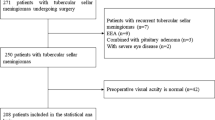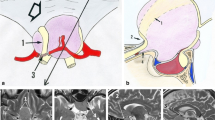Abstract
Background
Tuberculum sellae meningiomas present a special challenge because of their proximity to major arteries, visual pathways, and the hypothalamus. The aim of this study was to determine the prognostic determinants of clinical and visual outcomes of these tumors, focusing on the functional reversibility of an unserviceable eye after surgery.
Methods
We retrospectively reviewed 86 patients on the basis of clinical and radiological factors that appeared to affect outcome. The visual acuity and visual fields were analyzed according to the visual impairment score (VIS). Unserviceable visual acuity included no perception of light (NPL), hand movement (HM), and counting fingers (CF). Ophthalmological functioning was tested in the preoperative period, the postoperative short-term period (≤2 weeks after surgery), and the postoperative long-term period (>6 months after surgery). Our own clinical outcome criteria including tumor control, visual improvement, and complications were used for evaluation.
Results
Seventy-four of 86 patients (86 %) underwent total removal of the tumor. In three of these cases (3.4 %), recurrence developed. Thirty patients were classified into the “Excellent” group, 21 into the “Good” group, 20 into the “Fair” group, and 15 into the “Poor” group. In multivariate analysis, adhesion to optic nerve was an independent and significant predictor of clinical outcome. Favorable visual outcomes in both short- and long-term postoperative periods were achieved in 80.8 % of cases. Preoperative and short-term visual outcomes were closely related to long-term visual outcome. Six of eight patients with preoperative CF status showed reversibility to a serviceable status after surgery. However, there was no conversion to serviceable status from NPL or HM.
Conclusions
For patients with unilateral unserviceable visual function, maintenance of serviceable visual function on the opposite side might be more important. Of the patients with unserviceable visual function, careful surgery might be able to improve the visual function in CF eyes.

Similar content being viewed by others
References
Arai H, Sato K, Okuda, Miyajima M, Hishii M, Nakanishi H, Ishii H (2000) Transcranial transsphenoidal approach for tuberculum sellae meningiomas. Acta Neurochir (Wien) 142:751–756, discussion 756–757
Bassiouni H, Asgari S, Stolke D (2006) Tuberculum sellae meningiomas: functional outcome in a consecutive series treated microsurgically. Surg Neurol 66:37–44, discussion 44–35
Chokyu I, Goto T, Ishibashi K, Nagata T, Ohata K (2011) Bilateral subfrontal approach for tuberculum sellae meningiomas in long-term postoperative visual outcome. J Neurosurg 115:802–810
Fahlbusch R, Schott W (2002) Pterional surgery of meningiomas of the tuberculum sellae and planum sphenoidale: surgical results with special consideration of ophthalmological and endocrinological outcomes. J Neurosurg 96:235–243
Ganna A, Dehdashti AR, Karabatsou K, Gentili F (2009) Fronto-basal interhemispheric approach for tuberculum sellae meningiomas; long-term visual outcome. Br J Neurosurg 23:422–430
Gardner PA (2008) A brief history of the rise and fall of the School Medical Service in England. Public Health 122:261–267
Goel A, Muzumdar D, Desai KI (2002) Tuberculum sellae meningioma: a report on management on the basis of a surgical experience with 70 patients. Neurosurgery 51:1358–1363, discussion 1363–1354
Jaeger W, Thomann H (1982) German Ophthalmological Association. Recommendations for evaluation of reduced earning capacity caused by damage to vision. September 1981. Klin Monatsbl Augen 180:242–244
Jallo GI, Benjamin V (2002) Tuberculum sellae meningiomas: microsurgical anatomy and surgical technique. Neurosurgery 51:1432–1439, discussion 1439–1440
Kadis GN, Mount LA, Ganti SR (1979) The importance of early diagnosis and treatment of the meningiomas of the planum sphenoidale and tuberculum sellae: a retrospective study of 105 cases. Surg Neurol 12:367–371
Kim TW, Jung S, Jung TY, Kim IY, Kang SS, Kim SH (2008) Prognostic factors of postoperative visual outcomes in tuberculum sellae meningioma. Br J Neurosurg 22:231–234
Kunicki A, Uhl A (1968) The clinical picture and results of surgical treatment of meningioma of the tuberculum sellae. Cesk Neurol 31:80–92
Leveque S, Derrey S, Martinaud O, Gerardin E, Langlois O, Freger P, Hannequin D, Castel H, Proust F (2011) Superior interhemispheric approach for midline meningioma from the anterior cranial base. Neuro-Chirurgie 57:105–113
Li-Hua C, Ling C, Li-Xu L (2011) Microsurgical management of tuberculum sellae meningiomas by the frontolateral approach: surgical technique and visual outcome. Clin Neurol Neurosurg 113:39–47
Liu JK, Christiano LD, Patel SK, Eloy JA (2011) Surgical nuances for removal of retrochiasmatic craniopharyngioma via the endoscopic endonasal extended transsphenoidal transplanum transtuberculum approach. Neurosurg Focus 30:E14
Mahmoud M, Nader R, Al-Mefty O (2010) Optic canal involvement in tuberculum sellae meningiomas: influence on approach, recurrence, and visual recovery. Neurosurgery 67:ons108–ons118, discussion ons118–109
Margalit NS, Lesser JB, Moche J, Sen C (2003) Meningiomas involving the optic nerve: technical aspects and outcomes for a series of 50 patients. Neurosurgery 53:523–532, discussion 532–523
Nakamura M, Roser F, Struck M, Vorkapic P, Samii M (2006) Tuberculum sellae meningiomas: clinical outcome considering different surgical approaches. Neurosurgery 59:1019–1028, discussion 1028–1019
Ohta K, Yasuo K, Morikawa M, Nagashima T, Tamaki N (2001) Treatment of tuberculum sellae meningiomas: a long-term follow-up study. J Clin Neurosci 8(Suppl 1):26–31
Park CK, Jung HW, Yang SY, Seol HJ, Paek SH, Kim DG (2006) Surgically treated tuberculum sellae and diaphragm sellae meningiomas: the importance of short-term visual outcome. Neurosurgery 59:238–243, discussion 238–243
Puchner MJ, Fischer-Lampsatis RC, Herrmann HD, Freckmann N (1998) Suprasellar meningioma. A disease still frequently diagnosed too late. Dtsch Med Wochenschr 123:991–996
Sade B, Lee JH (2009) High incidence of optic canal involvement in tuberculum sellae meningiomas: rationale for aggressive skull base approach. Surg Neurol 72:118–123, discussion 123
Schick U, Hassler W (2005) Surgical management of tuberculum sellae meningiomas: involvement of the optic canal and visual outcome. J Neurol Neurosurg Psychiatry 76:977–983
Solero CL, Giombini S, Morello G (1983) Suprasellar and olfactory meningiomas. Report on a series of 153 personal cases. Acta Neurochir (Wien) 67:181–194
Terasaka S, Asaoka K, Kobayashi H, Yamaguchi S (2011) Anterior interhemispheric approach for tuberculum sellae meningioma. Neurosurgery 68:84–88, discussion 88–89
Zevgaridis D, Medele RJ, Muller A, Hischa AC, Steiger HJ (2001) Meningiomas of the sellar region presenting with visual impairment: impact of various prognostic factors on surgical outcome in 62 patients. Acta Neurochir (Wien) 143:471–476
Acknowledgments
This study was supported by a grant of the Korea Healthcare technology R&D Project, Ministry for Health & Welfare Affairs, Republic of Korea. (A092255)
Conflicts of interest
None.
Author information
Authors and Affiliations
Corresponding author
Rights and permissions
About this article
Cite this article
Seol, H.J., Park, HY., Nam, DH. et al. Clinical outcomes of tuberculum sellae meningiomas focusing on reversibility of postoperative visual function. Acta Neurochir 155, 25–31 (2013). https://doi.org/10.1007/s00701-012-1551-6
Received:
Accepted:
Published:
Issue Date:
DOI: https://doi.org/10.1007/s00701-012-1551-6




